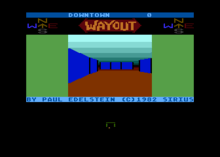Wayout
| Wayout | |
|---|---|
| Developer(s) | Sirius Software |
| Publisher(s) | Sirius Software |
| Designer(s) | Paul Allen Edelstein |
| Platform(s) | Atari 8-bit Apple II Commodore 64 |
| Release date(s) | Atari 8-bit & Apple II 1982 Commodore 64 1983 |
| Genre(s) | Maze |
| Mode(s) | Single player |
Wayout is a 3D, first-person perspective, video game programmed by Paul Allen Edelstein, originally released for the Atari 8-bit in 1982. It was among the first maze games to offer full 360 degree 3D perspective and movement, and its graphics were considered "state-of-the-art" at the time.[1] Most other contemporary Maze games (such as 3D Monster Maze, Phantom Slayer and 3-Demon) used a 'fixed' perspective and only 4-way movement, whereas Wayout allowed players to move freely within the 3D environment of the maze.
Gameplay

The player is trapped inside one of 26 mazes and must find the exit with the use of a compass and a map-making kit. The game automatically maps the areas you explore and records how many movement units the player uses up, saving the best scores to the game disk.
There is also a computer controlled opponent called the "Cleptangle" who appears as a spinning rectangular form which moves around the maze and will render the player's compass and mapmaker useless by 'stealing' them if it comes in to contact with the player.
In addition, there is a 'wind' within each maze, which blows in a constant direction, and is visualised by the presence of 'Fireflies' (represented by single pixels, moving through the maze). The 'wind' can sometimes be too strong for the player to push against, but it can also help the player locate the exit of the maze.
The 'mapmaker' function, which appears in the lower portion of the screen, is a top-down, 2D view of the maze the player inhabits, and draws itself as you move around, in a very similar way to the 'automap' feature which became prevalent in many later first-person shooters such as Doom.
Controls
The game could be played with either a joystick, paddles or the keyboard, allowing the player to move forward and turn left or right (but not backwards).
Reception
Creative Computing magazine in 1983 described Wayout as "deliciously addictive"; although the reviewer, Chris Vogeli, admits to being initially frustrated until he realised the exit could be anywhere on the map, and not just at the edge.[2] Antic Magazine's David Duberman wrote in 1983, "The graphics that appear before you as you move through the maze are more life-like and dramatic than I have ever seen. The 3-D animation... makes this game the last word in alternate-reality simulation".[1] Softline in 1983 stated that Wayout "features smooth-scrolling, truly three-dimensional mazes ... to torture your mind ... not recommended for vertigo sufferers".[3] Wayout was described in 1983 as having "superb 3-D graphics" by Electronic Fun, but was criticised for the lack of variety in the colours of each maze (they are all blue), which could lead the player to become "very disoriented".[4] Ahoy! 's reviewer stated that "Maze games generally leave me cold. To my surprise, I found Wayout a complete delight" and superior to Tunnel Runner and Escape from the Mindmaster. He concluded, "Maze game fans—pounce on this one".[5]
Sequel
Paul Edelstein's follow up to Wayout was a similar maze game called 'Capture The Flag', released the following year, which allowed two-player competition.
External links
References
- ↑ 1.0 1.1 Duberman, David (February 1983). "WAYOUT". ANTIC VOL. 1, NO. 6 / PAGE 83.
- ↑ Vogeli, Chris (February 1983). "WAYOUT". CREATIVE COMPUTING VOL. 9, NO. 2 / PAGE 88.
- ↑ Shore, Howard A. (1983-03). "Wayout". Softline. pp. 36–37. Retrieved 28 July 2014. Check date values in:
|date=(help) - ↑ "Wayout". Electronic Fun. June 1983.
- ↑ Hallassey, Dan (1984-03). "Congo Bongo". Ahoy!. p. 60. Retrieved 27 June 2014. Check date values in:
|date=(help)